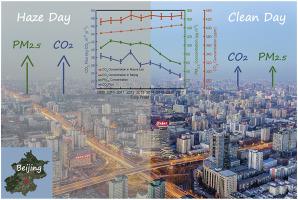Environmental Pollution ( IF 7.6 ) Pub Date : 2020-07-04 , DOI: 10.1016/j.envpol.2020.115014 Zan Liu 1 , Zirui Liu 2 , Tao Song 3 , Wenkang Gao 2 , Yinghong Wang 2 , Lili Wang 2 , Bo Hu 2 , Jinyuan Xin 2 , Yuesi Wang 4

|
Long-term CO2 and PM2.5 measurements in urban areas have important impacts on understanding the roles of urbanization in climate change and air pollution. From 2009 to 2017, CO2 fluxes were measured by the eddy covariance (EC) system at a height of 140 m on the Beijing Meteorological Tower. The CO2 fluxes followed a typical two-peak diurnal pattern all year round. The PM2.5 concentrations followed a similar diurnal pattern as the CO2 fluxes in summer but a different diurnal pattern in winter (low in the day and high at night). On a seasonal time scale, both the CO2 fluxes and the PM2.5 concentrations showed a pronounced seasonal variation (high in winter and low in summer). The spatial variations in CO2 fluxes were dominated by the prevailing land use types within the flux footprint, particularly dense residential areas and heavy traffic roads. On both diurnal and annual time scales, the urban underlying surface was a net source of CO2. The 9-year average annual total CO2 flux was 36.4 kg CO2·m−2 yr−1. Depending on the yearly prevailing wind direction, the effect of the heterogeneity correction on the annual total CO2 fluxes based on the gap-filled dataset could reach up to 3.5%. Over the 9-year period, both the CO2 fluxes and the PM2.5 concentrations exhibited a declining interannual trend, and CO2 fluxes could account for 64% of the interannual variability in PM2.5 concentrations. In summer, emissions were more likely to control the interannual variability in PM2.5 concentrations, whereas in winter, meteorological conditions had a greater impact on the interannual variability in PM2.5 concentrations.











































 京公网安备 11010802027423号
京公网安备 11010802027423号